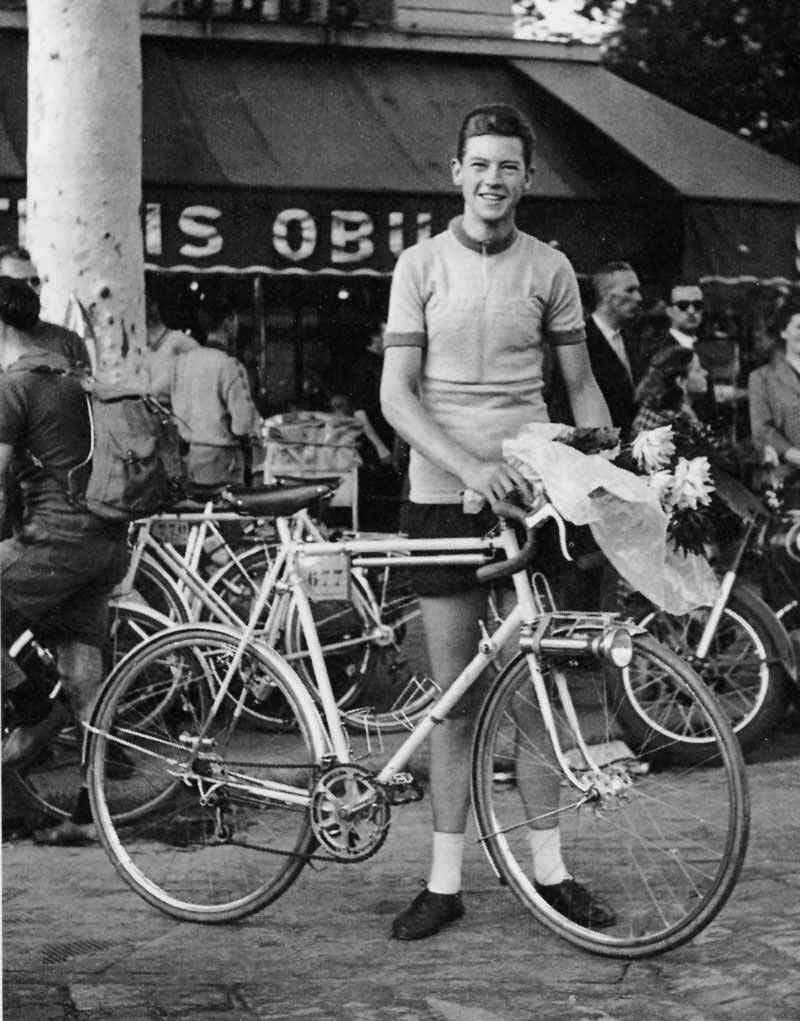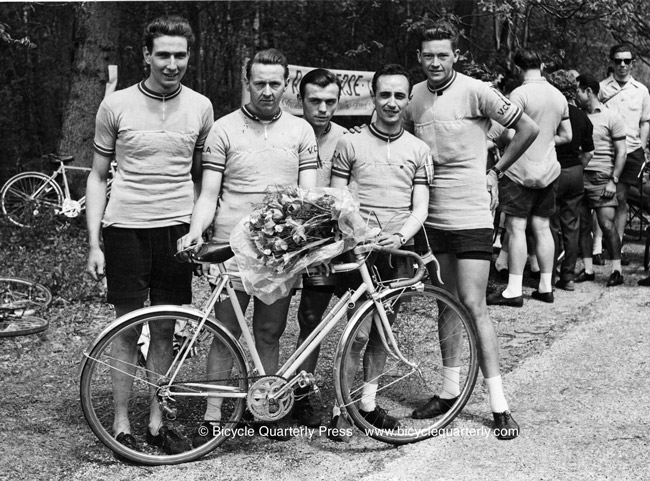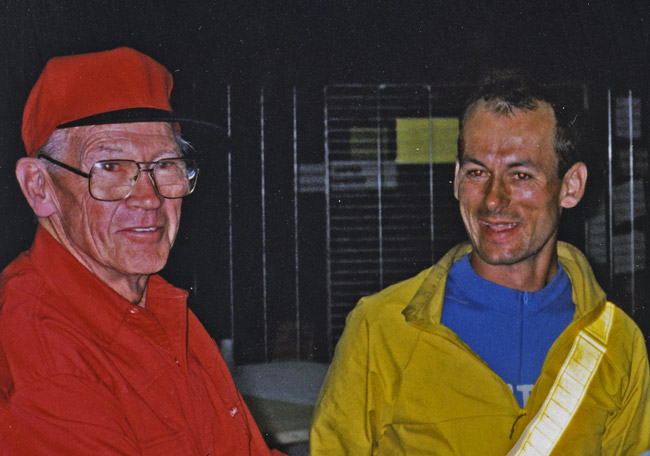People who have inspired us: Roger Baumann

I learned about the history of Paris-Brest-Paris from the late Bernard Déon’s excellent book Paris-Brest et Retour (unfortunately out of print). Déon was a great storyteller, and I found his report from the epic 1956 particularly gripping. The main protagonist of that dramatic edition of PBP was a young Roger Baumann. He rode the René Herse shown above through wind and rain, fought off a challenge from a late-charging Jean Lheuillier, and arrived back in Paris as the first of the single bikes. What a story!
When my friend Hervé mentioned that Roger Baumann was alive and well, I was excited. Maybe I could meet my hero? Bernard Déon put us in touch, and the next time I was in Paris, I met the “Grand Roger” for an interview and lunch. I discovered a man who was not only passionate about sport and performance, but also a true cyclotourist. His cycling exploits show the broad interests of cyclotourists at the time: He set a 24-hour record on the track “because I loved long distances, and this was as long as they came.” He was one of the first randonneurs to complete the Raid Pyrénéen, “an event harder than Paris-Brest-Paris.” He was part of a number of record-setting Flèche teams. As a cyclotourist, he enjoyed traveling all the way to Norway by bike. On all his rides, he took a keen interest in the landscape and culture he was visiting. He was a “grand randonneur.”
When I asked about his beautiful bike, Roger Baumann told me how he had dreamed of a René Herse bicycle for years: “During my lunch break, I took the Métro to Levallois-Perret, and looked at Herse’s shop window. I didn’t dare go inside.” He told me how in 1952, he bought his Herse with all his savings. He related his excitement when Herse told him later that year: “You are riding well. From now on, we will equip you.” Below he is part of the winning team at the 1955 Coupe Herse, a 100 km 5-man team time trial (left to right): Boris Brumat, Colliot, Jean-Marie Comte, Gilbert Bulté, R. Baumann.

Meeting Roger Baumann inspired me in many ways. I wanted to record and share his wonderful stories, so I started Bicycle Quarterly to publish them as well as other first-hand accounts from the “golden age of randonneuring.”
The “Grand Roger” (he got his nickname because he is 6 feet tall) also inspired my riding. I had been discouraged from riding at night by a rainy, miserable Flèche 24-hour ride on a fender-less racing bike. Then Roger Baumann’s told me of cresting the Tourmalet in the middle of the night during the Raid Pyrénéen. He talked of riding long distances non-stop and of carefully planning one’s schedule. This made me realize that I had been missing out on some of what makes randonneuring so special. A few months later, I rode my first 600 km brevet non-stop, and I enjoyed it. From then on, I aspired to become a “grand randonneur,” too.
Since then, I have remained in touch with Roger Baumann. We meet for dinner when I am in Paris, and we often talk on the phone. When I rode the 2003 PBP with Jaye Haworth on a 1946 René Herse tandem, he asked me: “When do you think you will be at the control of Fougères?” I told him that our schedule had us there around 5:30 a.m. Partly by chance, it was 5:30 on the dot when we pulled up to the school in Villaines-la-Juel. Despite the early hour, Roger Baumann was waiting outside. He checked his watch and said: “You are on schedule. Very good. Would you like to join me for a cup of tea?” When we told him that we did not plan to stop, he replied: “Even better. I will see you in Paris.”

When we arrived back in Paris almost two days later, it was 2:45 a.m. The volunteer checking us in asked, “Are you Monsieur AINe?” Then he yelled, “Somebody get Roger Baumann!” It turned out the “Grand Roger” had asked to be awoken when we arrived. A few minutes later, he arrived and congratulated us (photo above), which made our finish even more special. Two days later, he stood up for us when our trophy for the fastest mixed tandem was claimed by two impostors at the awards ceremony, who ran off with it. In a rush, another trophy was found and presented at the end of the ceremony.
Four years later, I was thinking of the 1956 Paris-Brest-Paris again as I rode toward Paris. Not only was this 2007 PBP as rainy and windy as the one 51 years earlier, but I was facing a situation similar to Baumann’s. Even though I was not racing for first place against somebody else, I knew I had to ride all-out if I wanted to achieve the magic sub-50-hour goal. After several hours of all-out effort, I arrived at the final control at the Human Rights Gymnasium in Saint-Quentin totally exhausted. Roger Baumann was there to greet me.
Last year, after my wonderful ride in the Raid Pyrénéen, I told Roger Baumann how I had been unable to find a hotel at the finish, and camped out in the hills overlooking the Mediterranean Sea. He replied: “If you had told me, I could have given you the address of a very nice bench near the train station, where I slept after my Raid in 1952.”
I have known Roger Baumann for 12 years now. Lately we have been talking several times a week, as he has helped me tremendously with research for another book. His excellent memory, his passion and his sense of humor make each of those conversations memorable. I look forward to seeing him again in Paris, when we’ll discuss cycling and the world over an excellent dinner.
Further reading:
- Bicycle Quarterly Vol. 1, No. 2 includes both the story of the 1956 PBP (translated from B. Déon’s book) and the interview with Roger Baumann.
- The Raid Pyrénéen (Bicycle Quarterly Vol. 10, No. 2, available online)


